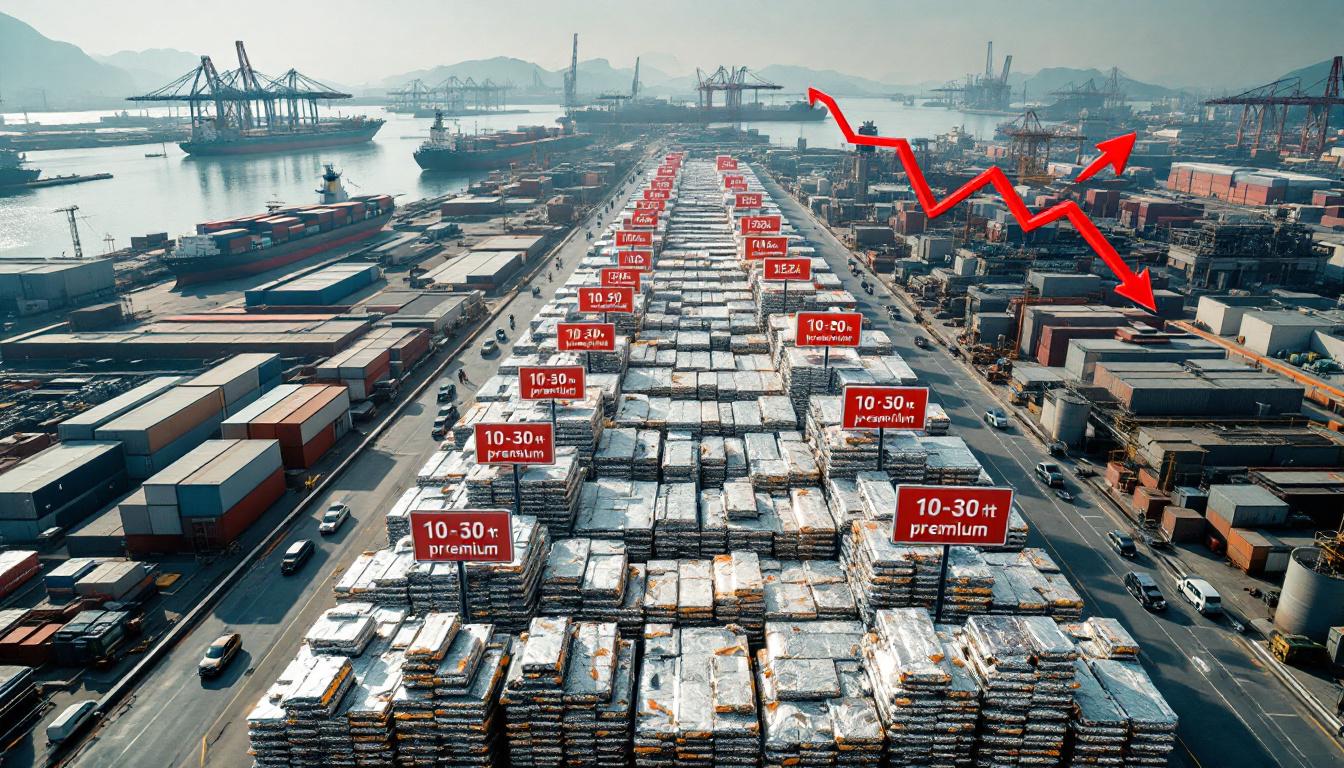Understanding the SHFE/LME Zinc Price Ratio: A Market Barometer
The SHFE/LME zinc price ratio serves as a critical indicator in global metals markets, offering valuable insights into trade dynamics between the world's two primary zinc trading hubs. This ratio—calculated by dividing the Shanghai Futures Exchange (SHFE) zinc price by the London Metal Exchange (LME) zinc price after adjusting for the USD/CNY exchange rate—functions as a key barometer for market participants worldwide.
At its core, this ratio reveals the relative pricing of zinc in Chinese versus international markets. When the ratio rises above certain thresholds, it typically signals potential arbitrage opportunities for traders who can capitalize on regional price differences.
The Mathematical Framework Behind the Ratio
The calculation itself is relatively straightforward: take the SHFE zinc price (denominated in CNY), divide it by the LME zinc price (in USD), and account for the current USD/CNY exchange rate. While simple in concept, the resulting figure carries significant weight in determining trade flows.
Market participants have historically identified the 8.0 threshold as particularly significant. When the ratio exceeds this level, importing zinc into China theoretically becomes profitable after accounting for associated costs like freight, insurance, and tariffs impact investment. Below this threshold, imports become economically unattractive, effectively closing what traders refer to as the "import window."
Significance Beyond Numbers
The ratio's importance extends far beyond simple calculations. It serves as:
- A real-time indicator of regional supply-demand imbalances
- An early warning system for potential trade flow shifts
- A benchmark for pricing discussions between producers and consumers
- A key reference point for commodity traders seeking arbitrage opportunities
For industrial consumers and producers, monitoring this ratio provides essential context for contract negotiations and supply chain planning. Meanwhile, traders vigilantly track the ratio to identify profitable import/export opportunities as markets fluctuate.
Current SHFE/LME Ratio Status and Trade Implications
As of early July 2025, the SHFE/LME zinc price ratio has been oscillating near 8.1, representing a noticeable pullback from previous levels. This current position places the ratio in a particularly interesting territory—just above the traditional 8.0 threshold but still insufficient to trigger significant import activity.
Import Window Analysis
The current ratio level has effectively closed the zinc ingot import window into China. Despite sitting above the theoretical 8.0 threshold, the 8.1 ratio fails to compensate for the full range of costs associated with importing:
- International freight rates (currently elevated due to shipping constraints)
- Insurance premiums
- Value-added tax considerations
- Customs clearance expenses
- Warehousing and financing costs
These additional expenses effectively raise the true breakeven ratio to approximately 8.2-8.3 for most importers in the current environment, explaining why the window remains closed despite the ratio exceeding 8.0.
Market Equilibrium Disruption
This closed import status has significant implications for China's domestic zinc market balance. With imports economically unattractive, the Chinese market must rely more heavily on domestic production to meet demand. This situation typically:
- Places upward pressure on domestic premiums
- Increases the importance of domestic production volumes
- Creates inventory drawdowns at SHFE warehouses
- Widens the gap between domestic and international price movements
For traders, the closed window eliminates certain arbitrage strategies while potentially creating new opportunities in the derivatives market as price differentials evolve.
Key Factors Driving Current Zinc Price Dynamics
Multiple economic indicators and geopolitical developments are currently influencing zinc prices across both the LME and SHFE exchanges, creating a complex market environment.
Macroeconomic Influences
The U.S. dollar index has demonstrated notable volatility, initially declining before strengthening in recent sessions. This currency movement directly impacts dollar-denominated LME zinc prices, with a stronger dollar typically pressuring prices downward.
June's ADP employment figures revealed a decrease of 33,000 jobs—the largest decline since March 2023. This significant labor market weakness has heightened expectations for multiple Federal Reserve interest rate cuts in 2025, creating a supportive environment for commodity prices impact despite dollar strength.
"The surprising weakness in ADP employment data has substantially shifted market expectations toward more accommodative monetary policy, providing support for base metals despite ongoing economic concerns." — Market analysis from SMM News, July 4, 2025
Regional Economic Indicators
China's official manufacturing PMI registered at 49.7 in June, showing improvement from the previous month while remaining below the expansion threshold of 50. More encouragingly, the Caixin manufacturing PMI (which focuses more on private and export-oriented firms) demonstrated stronger performance, boosting market confidence.
Despite these improved manufacturing indicators, downstream zinc consumption in China remains "generally in the doldrums," creating a disconnect between financial market optimism and physical market reality. This divergence has contributed to price volatility as traders attempt to reconcile conflicting signals.
Market Sentiment Metrics
The interplay between these factors has created a sentiment divide:
- Overseas markets: Generally optimistic due to rate cut expectations
- Domestic Chinese markets: More cautious amid weak downstream demand
- Overall sentiment: Increasingly risk-averse as trade policy deadlines approach
This sentiment divergence has translated into differing price performances between the LME and SHFE markets, directly impacting the SHFE/LME ratio.
Geopolitical Factors Affecting Zinc Markets
Global zinc markets are increasingly influenced by evolving trade policies and geopolitical tensions, with several recent developments capturing market attention.
Trade Policy Developments
The passage of the "Big and Beautiful Act" in the U.S. Senate represents a significant policy shift with potential implications for metal markets. While specific provisions affecting zinc trade aren't fully detailed, the legislation appears to continue the trend toward more protectionist trade policies.
More immediately, market participants are closely monitoring the approaching July 9 deadline for trade tariff suspensions. This critical date has increased risk-aversion throughout commodity markets as traders position for potential disruptions to established trade flows.
Historical Context and Current Impact
The zinc market has proven particularly sensitive to trade policy shifts in recent years. Previous rounds of US tariffs and inflation have significantly altered traditional trade patterns, creating:
- Diverted trade flows to circumvent tariff barriers
- Price premiums in markets with restricted import access
- Increased volatility in the SHFE/LME ratio
- Development of alternative supply chains
The current geopolitical environment suggests these trends may intensify rather than abate, creating both challenges and opportunities for market participants.
Regional Response Differences
Market reactions to these developments have varied significantly by region:
- Chinese domestic market: Increased caution amid uncertainty
- European consumers: Concerns about potential supply disruptions
- North American buyers: Preparing for possible price volatility
These divergent responses further contribute to regional price differentials and ratio fluctuations.
SHFE/LME Zinc Price Ratio Outlook
The SHFE/LME zinc price ratio is expected to maintain a fluctuating trend in the coming weeks, with several key factors likely to influence its trajectory.
Short-Term Projections
In the immediate term, the ratio is likely to continue oscillating around current levels (8.1), with potential volatility surrounding the July 9 trade policy deadline. Market analysts anticipate that any significant movement will depend primarily on:
- USD/CNY exchange rate developments
- Trade policy implementations
- Divergent regional demand patterns
- Shifts in global risk sentiment
"While fundamentals suggest continued ratio stability, event risk surrounding policy implementation could trigger sharp but temporary ratio movements." — Analysis implied from SMM reporting, July 2025
Medium-Term Considerations
Looking further ahead, several structural factors will determine whether the import window might reopen:
- Seasonal demand patterns: Chinese zinc consumption typically strengthens in Q3
- Production constraints: Both domestic and international smelter operations face challenges
- Monetary policy divergence: Different rate paths between China and the U.S.
- Inventory dynamics: Warehouse stocks across both exchanges
The combination of these factors suggests continued ratio volatility with a slight bias toward widening in the medium term, though significant US‑China trade war developments could rapidly alter this outlook.
Strategic Approaches for Market Participants
The current zinc market environment—characterized by a closed import window and elevated geopolitical uncertainties—requires thoughtful strategic approaches from various market participants.
Importer and Trader Strategies
For those typically engaged in zinc imports into China, the closed import window necessitates alternative approaches:
- Supply chain diversification: Exploring domestic sources or alternative import origins
- Hedging implementations: Using futures spreads to manage price differentials
- Contract structure optimization: Incorporating floating premiums linked to ratio levels
- Inventory management: Strategic positioning of stocks across different locations
Traders should maintain vigilant monitoring of ratio movements, with particular attention to the 8.2-8.3 level where import economics potentially become viable.
Producer and Consumer Considerations
Zinc producers and industrial consumers face their own strategic imperatives in the current environment:
- Contract pricing mechanisms: Implementing dual-reference pricing incorporating both SHFE and LME benchmarks
- Geographic optionality: Maintaining flexibility in sourcing and delivery locations
- Financial hedging: Using derivatives to manage exposure to regional price divergences
- Inventory optimization: Balancing working capital needs against supply security concerns
"The most successful market participants will be those who develop strategies accounting for both ratio volatility and prolonged import window closures, rather than simply waiting for market normalization." — Market implication from SMM analysis
Risk Management Framework
A comprehensive risk management approach should include:
- Scenario planning: Developing responses to various trade policy outcomes
- Ratio thresholds: Establishing clear action triggers at different ratio levels
- Information advantages: Developing superior insights into physical premiums and regional balances
- Optionality valuation: Structuring positions to benefit from increased volatility
FAQ: Essential SHFE/LME Zinc Price Ratio Questions
What causes the SHFE/LME zinc price ratio to fluctuate?
The ratio fluctuates due to several interconnected factors:
- Currency movements: USD/CNY exchange rate shifts directly impact the calculation
- Regional supply-demand balances: Localized shortages or surpluses affect regional pricing
- Trade policies: Tariffs, export restrictions, or import incentives alter trade economics
- Arbitrage activities: Trader actions seeking to capitalize on price differentials
- Warehouse stock movements: Inventory flows between exchanges influence regional pricing
Among these, currency movements typically drive short-term fluctuations, while supply-demand fundamentals and policy changes create more sustained shifts.
When is the zinc import window considered "open"?
The import window opens when the SHFE/LME ratio rises sufficiently to cover all costs associated with importing zinc into China. While the theoretical threshold is often cited as 8.0, the practical threshold varies based on:
- Current freight rates: Maritime shipping costs fluctuate significantly
- VAT considerations: Tax treatments and rebate policies
- Financing costs: Interest rates and credit availability
- Physical premiums: Regional delivery premiums above exchange prices
- Warehousing expenses: Storage and handling costs
In the current environment, most market analysts estimate the true threshold at approximately 8.2-8.3, explaining why the window remains closed despite the ratio exceeding 8.0.
How does the zinc ratio compare with other base metals?
Each base metal exhibits unique SHFE/LME ratio characteristics:
- Copper: Typically maintains more stable ratios due to deep liquidity in both markets
- Aluminum: Often shows lower ratio volatility due to significant production in both regions
- Nickel: Exhibits higher average ratios due to China's structural import dependence
- Lead: Shows patterns similar to zinc but with greater seasonal fluctuations
Zinc's ratio behavior is distinguished by its sensitivity to both industrial demand cycles and galvanizing sector activity, which creates distinctive seasonal patterns not present in other metals.
What economic indicators best predict ratio movements?
Several indicators have demonstrated predictive value for the SHFE/LME zinc ratio:
- PMI manufacturing data: Particularly the new orders subcomponents
- China real estate investment figures: Due to zinc's use in construction
- Auto production forecasts: Galvanized steel demand indicator
- USD/CNY forward curves: Anticipating currency movements
- Infrastructure spending announcements: Potential demand catalysts
Among these, China's manufacturing PMI has shown the strongest correlation with subsequent ratio movements, particularly when diverging significantly from global manufacturing trends.
Navigating Zinc Market Complexity
The SHFE/LME zinc price ratio serves as more than just a numerical indicator—it represents the culmination of global economic forces, policy decisions, and market participant behaviors. Understanding its nuances provides market participants with a powerful lens through which to view evolving market dynamics.
As geopolitical tensions and economic uncertainties continue to shape commodity markets, the ability to interpret ratio movements and position accordingly will remain a critical competitive advantage. By maintaining a disciplined approach to monitoring this key metric, market participants can better navigate the complexities of global zinc markets in an increasingly fragmented trading environment.
For additional context on broader commodity market trends, investors should also consider how iron ore price forecast data might provide complementary insights, as industrial metals often show correlated price movements driven by similar macroeconomic factors.
Disclaimer: This analysis is based on market conditions as of early July 2025. Forecasts and strategies should be considered in the context of rapidly evolving market conditions and individual risk tolerance. All investment and trading decisions should incorporate additional research and professional advice where appropriate.
Want to Spot the Next Major ASX Mineral Discovery?
Discovery Alert's proprietary Discovery IQ model delivers instant notifications on significant ASX mineral discoveries, empowering you to identify actionable opportunities before the broader market. Visit the Discovery Alert discoveries page to understand why historic discoveries can generate substantial returns and begin your 30-day free trial today.




